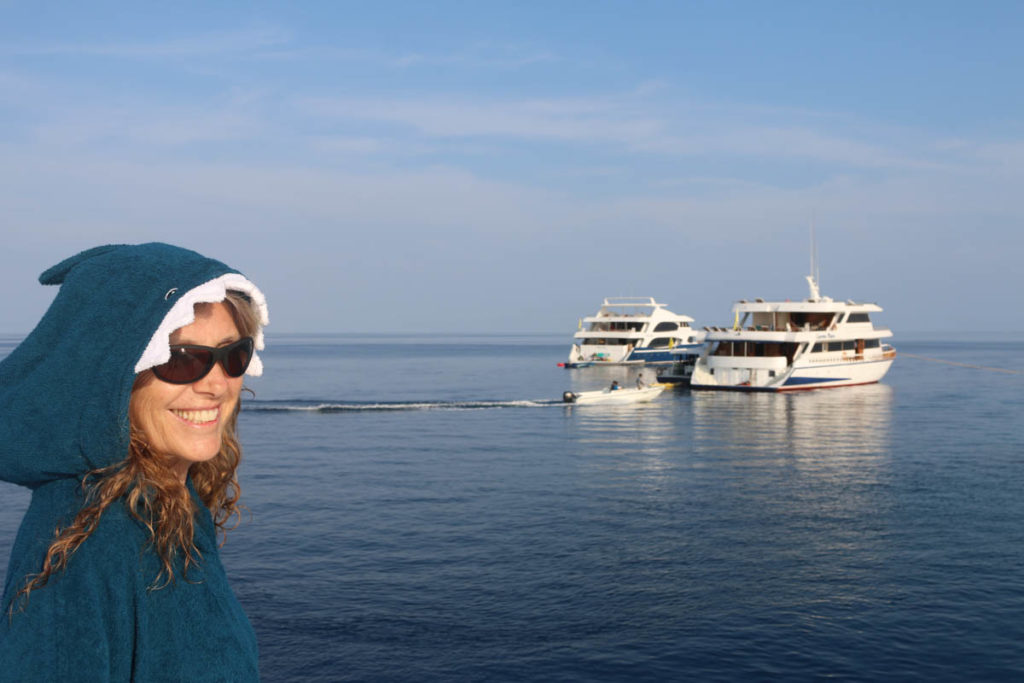The Maldivian archipelago, a water-level paradise formed by more than 2,000 islands is, at any time of the year, one of the most attractive destinations for any diver. Surrounded by the warm, inviting and transparent waters of the Indian Ocean, they are one of the most popular sanctuaries among diving destinations, where encounters with large pelagic fish, manta rays and sharks are not an exception, while rather a normality.
We met Donatella Telli, general manager of Albatros Top Boat/Luxury Yacht Maldives (LYM), the Italian leading yachting tour operator on the market since more than 30 years that, thanks to the great experience of Donatella and Massimo Sandrini, partner with whom Dodi started this adventure, specialized in cruising the Maldives. Neither Donatella, defined one of the best instructor of the whole archipelago, nor Luxury Yacht Maldives need presentations as they have been known since they started exploring those areas that back in the 1990s were, at the behest of the Maldivian government, still closed to tourists.
From classic cruises, so to speak, LYM has expanded the offer by creating themed cruises that allow guests to expand their knowledge of the marine fauna of the Maldives, becoming an active part in real scientific research (citizen science). So who better than Donatella Telli, DODI as her many friends call her, can invite us onboard their exclusive boats equipped with all comforts to tell us how to fully enjoy the wonders that the Maldives hide under water? Thus, zigzagging among the atolls, we will be given a holiday of the highest level that will not disappoint even the most demanding ones.
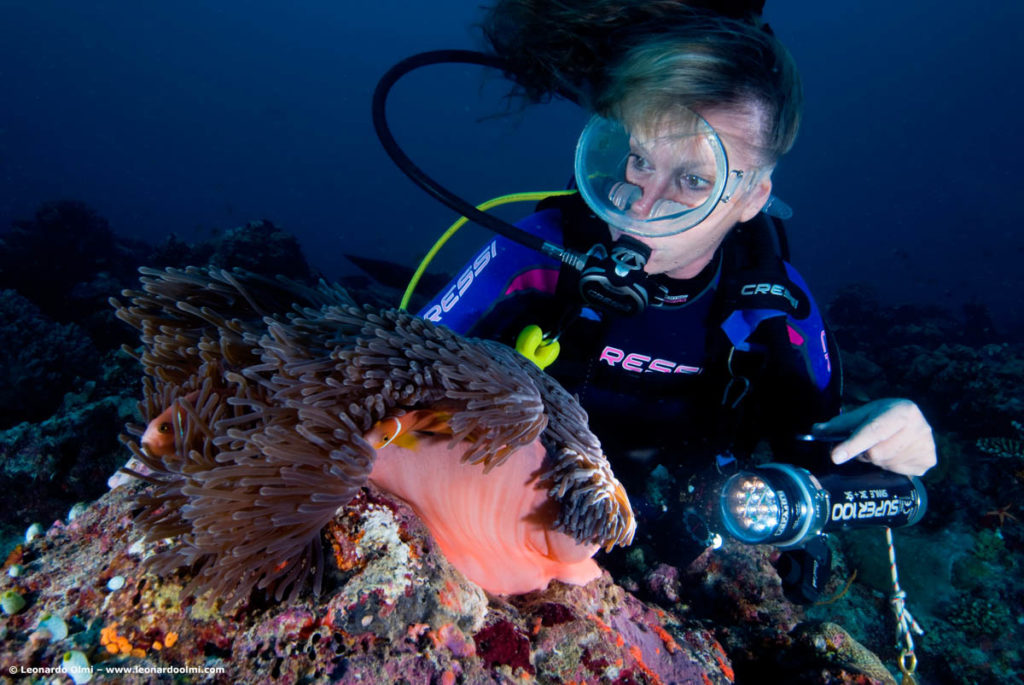
Dodi, neither you nor LYM need presentations in the environment of diving industry, you are so famous, but why don’t you briefly summarize your history, for those who have entered the world of diving in recent times?
I was young and like many young people I wanted to discover, to experiment, so much so that in 1985 I left Lake Maggiore to start working in the Maldives as a diving instructor. As such, I then became responsible for some diving centers, until in 1990 along with Massimo Sandrini, my current partner, we gave birth to Albatros Top Boat and then the brand for the foreigner markets LYM, organizing our first diving cruises.
We rented a boat and leaning on an Italian tour operator we took care of those divers who wanted to experience the Maldives outside the classic resorts, and cruising turned out to be a more than valid alternative. And I will tell you more, we were among the first to propose this type of holiday which proved to be a winner, so much so that we already turned the point of 30 years of constant commitment and dedication that has allowed me to collect many successes, thanks also to our loyal customers. At the beginning, being both myself and Massimo diving instructors, we mainly offered to people who came to the Maldives to dive, then over time our audience has expanded and today I can boast a truly heterogeneous clientele. As boat leaders for many years we used to cruise with our customers for 6/8 months a year, spending the rest of the time in Italy, where we managed a diving center which, over the years, we gave up, concentrating our efforts exclusively on the Maldives.
And how comes a young girl, as you were then, when you started, wanted to dedicate her whole life to the sea, and in particular to diving, confining herself to the Maldives?
Yes I was young. The love for the sea has always characterized my life choices so much so that at 27 I started working in the Maldives and at 32 I was cruising, and it was, as it often happens, the randomness in choosing a destination for the holidays to bring me right into the waters of the Indian ocean. It was love at first sight and it is thanks to this unconditional falling in love that this beautiful archipelago has become the central fulcrum of my whole life and work. Sometimes the choices that affect our life are said to be part of our DNA and I think it’s a bit what happened to me. I have always had a passion for traveling and a strong sense of organization, so much that the path of my studies has been based on tourism thus providing me with solid foundations on which to develop my professional growth. If we combine this with my passion for diving it goes without saying that developing these two skills simultaneously came naturally and this happened in one of the most beautiful seas in the world.
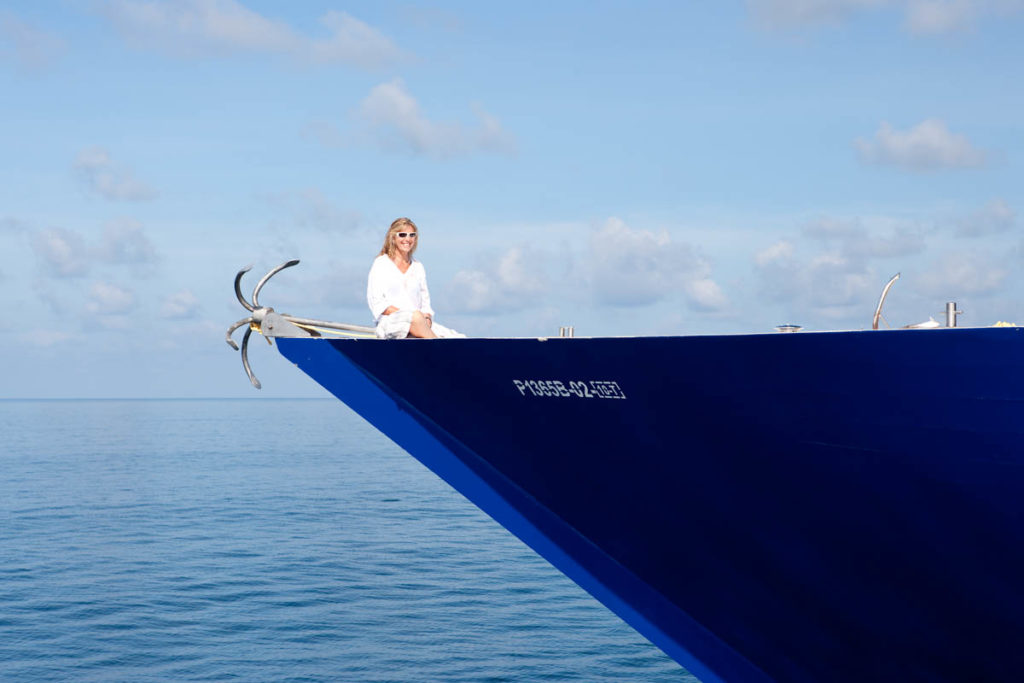
There is no doubt that you know this archipelago better than anyone else: is this very great experience of yours combined with your great underwater preparation that has allowed LYM to specialize in travel to the Maldives focusing on diving cruises?
If we want to make a comparison with other tour operators my knowledge is certainly that extra gear that LYM has. I don’t deny knowing Maldives better than Italy, from north to south. We started with certain types of cruises but at the same time we have always been a little curious about doing new things, and it is thanks to this longing for “adventure” that we were the first to organize diving cruises as much in the far north as in the far south, where those other few boats that used to cruise around at the time did not go. So I opened the cruise known as “Best Seven”, an itinerary built by us that goes to the far south of the archipelago beyond the equatorial channel. It’s 1991, times when most of the atolls were closed to tourism and when I speak of atolls I do not speak of islands but I speak of regions that in the Maldives are 26, while there are more than 2,000 islands, and in those years only the 4 central atolls, North Malè, South Malè, Ari and Felidhu were open to tourism.
Here there were only tourist resorts while all the other atolls in the North and South were completely pristine. The first few years, when we started organizing this cruise, which as I told you took us to sail to the far south, in addition to having all the government permits that allowed us to anchor and land on the various islands, we even had a policeman onboard. The first cruises lasted 15 days, relying on an airport belonging to the former British military base located in the Addu Atoll, which connected us to the capital, for the change of guests. And so, with the new customers on board, in another 15 days we retraced the itinerary that would lead us back to Malè. For us insiders it was a month-long cruise and this we have done for many years and I do not deny that I still retain some magnificent memories of it. Then the Maldivian government opened other atolls to tourism, greatly simplifying the bureaucratic aspect and removing the obligation to have our beloved policeman onboard. New internal airports have been opened, so much so that now the itinerary of this cruise no longer requires Addu airport but takes us to the splendid South Huvadhoo atoll, the third largest atoll in the world. I send there my boats in mid/late January, leave them down there for a couple of months engaging them in cruises inside the atoll itself and thanks to the local airport we have weekly connections with the international one in Malè.
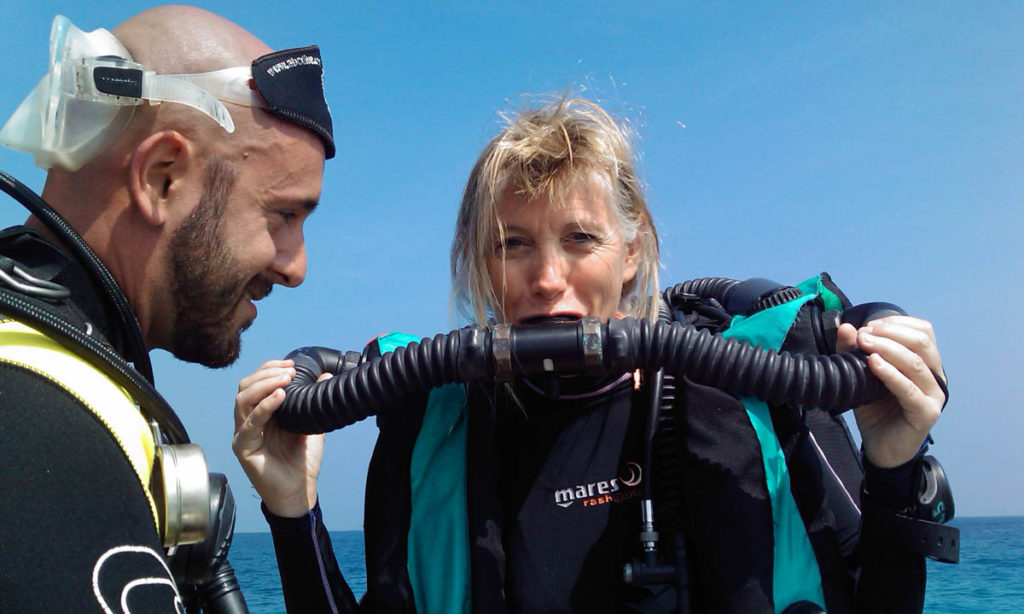
As you have approached the topic of thematic cruises, through which you put guests in the condition to participate in real scientific research as well: how did you come up with this idea?
I kept this idea in the drawer for a long time and finally I managed to implement it. As well as being a diving instructor, Massimo is also a geologist and oceanographer, a mix of skills that has always led us to go a little further than mere diving per se or the simple organization of a trip. This is to tell you that since the 90s we have started to collaborate with Italian universities especially with the University of Urbino and with the University of Genoa. And since then with these collaborations, at least once a year, we organize scientific cruises so much that this year, in 2020, we have reached the 23rd. At the beginning the themed cruises were limited to scientific cruises, with on board not only professors or university students who came to the Maldives to make the surveys related to their studies, but also simple divers curious to learn more.
On board the university professors make their knowledge available to guests, organizing pleasant and convivial evenings, aimed at making this splendid archipelago better known not only unde a geological point of view but also under a biological one. This way, real round tables were created to satisfy all the curiosities of the guests by alternating themes from evening to evening. This is one of the themed cruises that are still in the catalog and if we remain in the field of scientific cruises we have increased the offer with new collaborations. For three years we have been working with Dan Europe on a truly innovative project that no one has ever focused on so far. We speak of the “Flying Bubbles” project, aiming to study the time of “no-fly” after the last dive in which data collection already takes place on board the aircraft, which is why we put Dan Europe in contact with Neos, the airline that flies to the Maldives, and beyond.
Let’s leave the scientific cruises with this truly interesting project that certainly does not detract from the other themed cruises that we have in the catalog, such as the one related to freediving which has allowed us to work with Umberto Pellizzari, Mike Maric. Still in the Maldives we also offer cruises whose theme is that of diving on wrecks during which, with the collaboration of television troupes, documentaries are shot thus transforming our customers from simple guests to real protagonists.
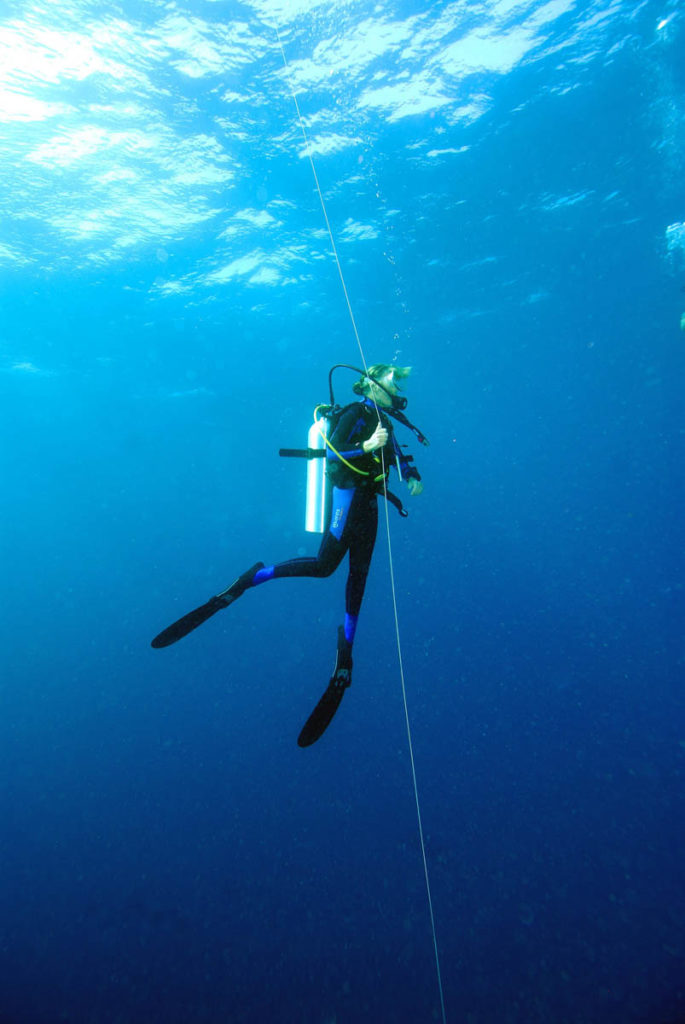
What itineraries do you propose?
Among the people who work on board we have dive masters who have been working with us for over 23 years and highly talented and professional instructors. It is undeniable that we are talking about the top among Maldivian connoisseurs and frankly I think LYM is the only company that works in the Maldives to have people who have collaborated for so long. If we combine this with my experience, an explosive cocktail will come out allowing us to really do everything, from the far north to the far south.
For most of the year, cruises take place in the central atolls, that is, North Malè, South Malè, Felidhu, Ari and Mulaku, all atolls offering very special itineraries by moving east or west, depending on the season that as you know, is staggered by two monsoons. I’ll give you an example. With a north east monsoon, what is also called “dry”, meaning the good season from December to June, we have currents that enter from the east of the atolls with very clear water, best condition to see pelagic fish. The water, rich in plankton, therefore “dirty” so to speak, comes out from the west where we are going to look for manta rays and whale sharks. When the monsoon changes, the conditions are reversed and so the west part, which was previously cloudy for the plankton, becomes clear, dirtying the east part that was previously crystalline. This is to explain that we do not have a well-defined and unique itinerary because, always remaining in the central atolls, the navigation routes are studied according to the seasonality and the weather conditions. The thing we love to do, and LYM is also known for this, is precisely that of organizing personalized cruises even with a good number of guests on board because in any case we always manage to offer the best of what can be done in that week. If the weather turns up we always have the alternative route. For example, if the navigation were to be too long and there was a strong wind we would never make the guests feel bad, we would immediately change the program while maintaining what we set ourselves. We are always able to organize “ad hoc” itineraries, giving top priority to the needs of our customers on every occasion.
What type of boats are used in your cruises?
We have full exclusivity of the boats and our Maldivian fleet is currently made by the Duke of York and Conte Max. “Conte Max” is a 34 meters long vessel with 9 cabins, while “Duke of York” is newer and is 36 meters long with 11 cabins able to host up to a maximum of 26 guests, including triple cabins.
The characteristics of both are those of having a yacht designed with three decks and all the facilities on board. Cabins with air conditioning and private services with hot and cold water, massage center, restaurants both outside and inside, solarium, library, boutique, Wi-Fi, and finally kayaks & sups on board and diving dhonis in tow . The diving dhoni is a boat of approximately 18 meters completely autonomous with three crew members following the mother boat, with a generator on board that powers all the electric compressors, for Air and Nitrox, where all diving equipment is also kept. It is a boat used a bit for everything, from transfers to and from the airport, to reaching the diving points, while the mother boat remains at anchor. The boats thus become real refined floating hotels without having smelly wetsuits hanging, regulators, jackets and all the diving or snorkeling equipment scattered on the three decks. When it is time to prepare for the dive, the diving dhoni joins the mother boat, the guests take a seat and, with a minimum of navigation, you are immediately ready for the dive. The use of this support boat is a feature of the Maldives, a not indifferent comfort that you will never find anywhere else in the world.
Can divers also use Nitrox onboard?
Yes, Nitrox is included in the price. In addition to Nitrox we also give the possibility of diving with rebreathers and also, in this case, we organize specific themed cruises. The only thing we ask our guests is to bring their own machines because it is not possible to rent them onboard, we will take care of the rest. Since last year, guests onboard have also found underwater scooters to dive with greater fun and ease.
How does a typical day go on a themed cruise?
To answer this question, I would tell you about another cruise that I haven’t told you yet, namely themed cruises with Manta Trust which, needless to say, is based in the Maldives. The collaboration with this British organization engaged in the study of manta rays has always been very successful, so much so that we organize several ones throughout the year dedicated precisely to the search for manta rays and whale sharks. Manta Trust has also invested us with the role of ambassador and as a matter of fact LYM is one of their reference points. Cruises are always accompanied by their biologist and can last for a week or more, and the itinerary cannot exclude the lagoon of Hanifaru Bay, north of the Baa atoll, where, thanks to special conditions, from July to October, there is such a concentration of manta rays that your jaw will drop. We are talking about 200, 300 specimens at a time! And having a biologist on board makes the difference. With the support of audiovisuals he/she will entertain guests by illustrating behaviors and habits, thus satisfying all their curiosities about the life of these beautiful animals. It goes without saying that, whether it occurs while diving or snorkeling, the encounter with these majestic creatures will have another flavor: the more you know the more you appreciate. In Hanifaru Bay we generally stop for a couple of days and then keep going in search of all the other beauties that the waters of the Maldives hide, with three dives per day plus night dives. As you can see, it does not take anything away from a normal cruise, where every day there is a guide who, while divers dive, accompanies people who wish to snorkel. For those who want to relax they can do it on the solarium or, when we anchor in front of a sand bank, lying on the fine coral sand or why not, pamper themselves with a nice massage.
There is no shortage of excursions to the tourist islands or those inhabited by fishermen, as well as the evening barbecue by candlelight on the deserted islands. This is a bit what happens during a themed cruise with Manta Trust, where the real difference between a classic cruise, so to speak, lies in the presence on board of a biologist who, with the help of a well-defined program, will provide the right key to better understand the life of manta rays and cartilage fish in general.
You told me about snorkeling so aren’t cruises custom built just for divers?
OF COURSE NOT. For several years now, we also offer our services to customers who are unfamiliar with cylinders, so much so that we have many people who come to the Maldives just to SNORKEL, to RELAX, to FISH, or even to surf. As you saw, we are extremely flexible and depending on the customers we have on board, the itinerary is organized according to their specific needs.
Within this planning, what is or what was, in your opinion, the most beautiful, most exciting cruise?
This is such a great question! It is very difficult to answer because the Maldives, from the underwater point of view, are truly a magnificent place both for those who dive with cylinders and for those who only snorkel. Unlike a permanent holiday which is what you can do in a resort, the one on a cruise is an ITINERANT HOLIDAY that allows you to reach the best points. Isn’t it true that “if the mountain does not go to Muhammad it will be Muhammad that will go to the mountain”? And it is for this reason that in a week you can really see everything even without being particularly lucky. We always manage to give top cruises and it is very difficult that, by the end of the week, the dives have not fully met the expectations of our customers, because, following the trend of the monsoons, we always see from pelagic fish to manta rays and whale sharks are not rare either. If I analyze the scientific aspect, I can tell you that the most exciting experience I have had was the discovery of BLUE HOLE, which apparently looked like a simple lagoon. As it often happens, it was Chance who chose Massimo: he dived to untangle the anchor and, being a geologist, he immediately realized that that seabed had something different from the usual. There was a bathymetry different from what he was accustomed to and so intrigued, he began to descend reaching a fair depth, soon realizing that he had entered an absolutely anomalous place compared to what we had seen until then in the Maldives.
We had discovered the only Blue Hole in the entire Indian Ocean which turned out to be a karst cave, with the typical stalactites and stalagmites, of when the Maldives were still 100 meters out of the water, so it was a cave dating back even before the last Wurmian glaciation. Unlike the very famous Blue Holes in Belize, which start from the surface, therefore clearly visible from above, this is a Blue Hole that starts from 30 meters, which is why you cannot see it from the surface even if you fly over it with a seaplane. It is truly Chance that helped us find it and it is always thanks to it that Massimo did it. We have spent a great deal of time studying this site, to which a section in the book we have published is dedicated, which collects and tells about all our scientific cruises and which, probably next year, will be released with a second updated edition. If we leave reason behind and give free rein to emotions, then the most engaging cruises are those aimed at observing manta rays and whale sharks where their delicacy and majesty have the power to enchant and amaze you at the same time. And if we talk about amazement, I can’t forget when, in ’91, we started to go to the “forbidden” areas sailing from north to south entering some islands where the inhabitants had never seen white men giving us indelible moments. I consider myself a very lucky person to have managed to get to the Maldives in a time when it was still possible to experience such great emotions. Telling them now seems almost a joke but I assure you it is a precious memory that I keep with great care.
Are there any dive spots you are most attached to?
Yes, especially those that we have discovered, and we have discovered many. Contrary to what is happening now, the first few years we did not have Maldivian dive masters who knew the places, nobody knew anything, so the same boatmen or captains who were driving the diving dhoni, followed our directions. We did not know where to go, where to jump, we went by “guts feeling”, only helped by nautical charts, and this led us to dive places where no one had ever done it before. The discovery itself, the knowledge that no one had been down there yet, as happened with all the dives we did on the first cruise to the far south, was electrifying. We also happened to find places where you could see huge schools of hammerhead sharks or where manta rays were uncountable. Pure adrenaline. We have given many names to the discovered diving spots making them a bit ours, so much so that there is a site called Dodi Tilla, where tilla in Maldivian means seamount/pinnacle, and one called Max Thila.



